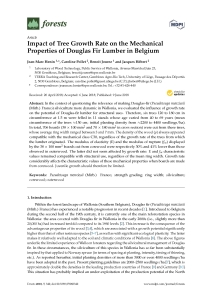Henin J.M., Pollet C., Jourez B., Hébert J.
Abstract: In the context of questioning the relevance of making Douglas-fir (Pseudotsuga menziesii (Mirb.) Franco) silviculture more dynamic in Wallonia, we evaluated the influence of growth rate on the potential of Douglas-fir lumber for structural uses. Therefore, six trees 120 to 180 cm in circumference at 1.5 m were felled in 11 stands whose age varied from 40 to 69 years (mean circumference of the trees 150 cm; initial planting density from 2200 to 4400 seedlings/ha). In total, 706 boards (38 100 mm2 and 70 180 mm2 in cross section) were cut from these trees, whose average ring width ranged between 3 and 7 mm. The density of the wood (r) always appeared compatible with the mechanical class C30, regardless of the growth rate of the trees from which the lumber originated. The modulus of elasticity (E) and the modulus of rupture (fm) displayed by the 38 100 mm2 boards cut from corewood were respectively 30% and 41% lower than those observed in outerwood. The latter did not seem affected by growth rate: E and fm characteristic values remained compatible with structural use, regardless of the mean ring width. Growth rate considerably affects the characteristic values of these mechanical properties when boards are made from corewood. Juvenile growth should therefore be limited.
Consultez la notice complète de l’article sur ORBi

